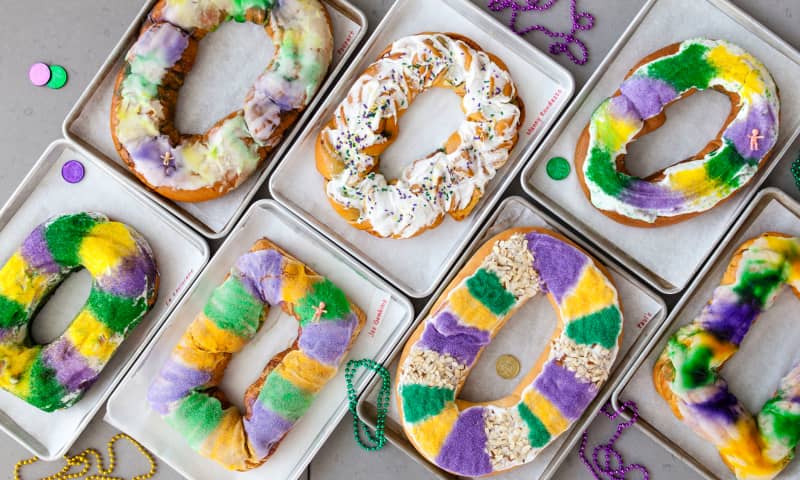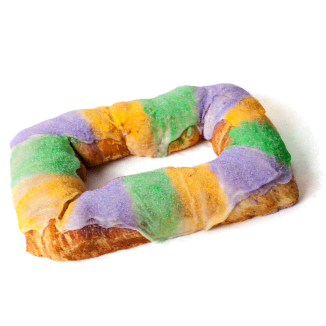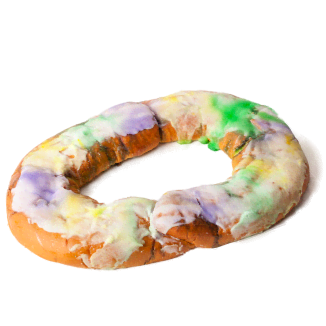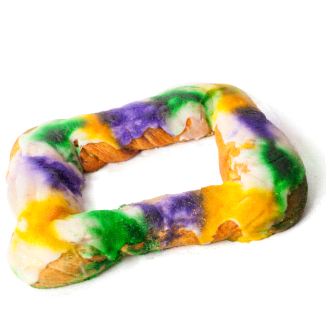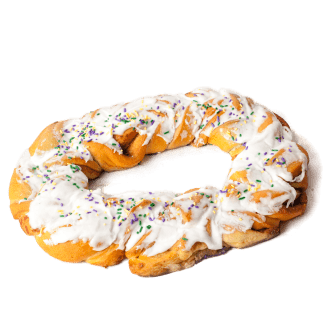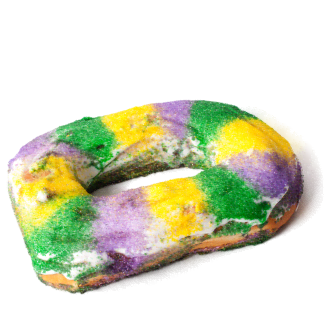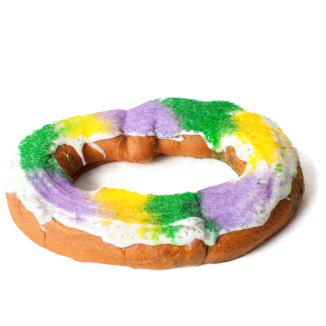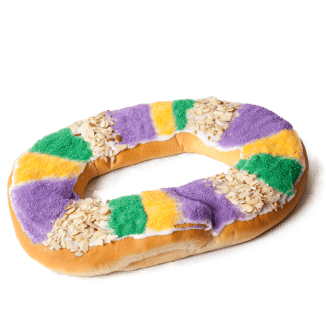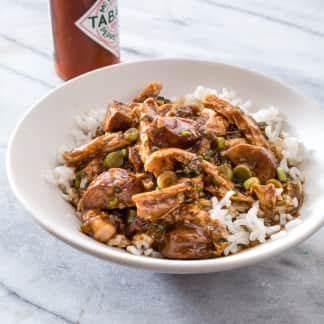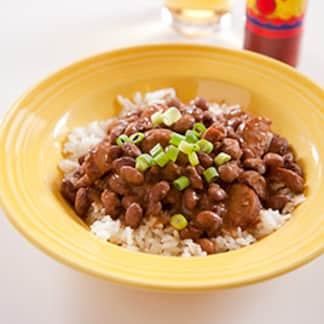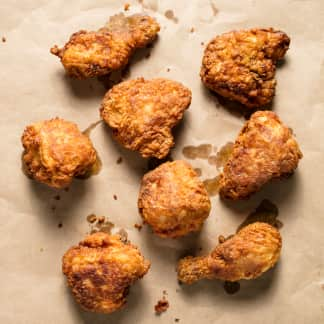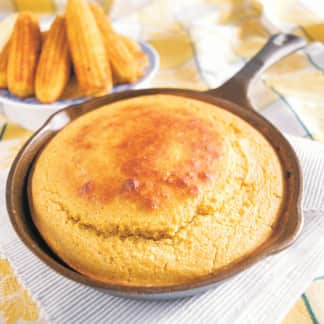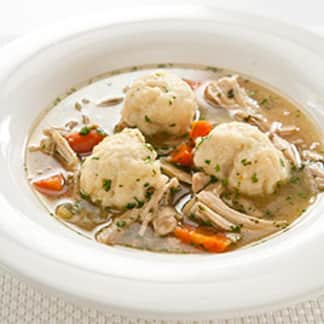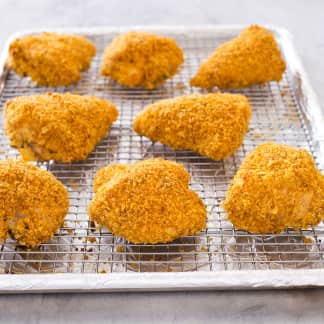There are three key Mardi Gras foods: fried chicken, king cake, and more king cake. Fried chicken is the ultimate portable parade food: Grab a bucket of Popeye’s and plant yourself on St. Charles Avenue to watch the floats and marching bands go by. King cake, though, is Mardi Gras in food form.
Growing up in Louisiana, I ate slices of this jewel-toned cake for weeks straight every year, from January 6—the official start of the Mardi Gras season—to Fat Tuesday, which is February 13 this year, but can fall anywhere from early February to early March. We ate king cake at home, in school, and even after swim practice, when we’d exit the pool and get cake first, towels second. King cake was paramount. And delicious.

What Is King Cake?
Reportedly brought to New Orleans from France in the late 19th century, king cake is a celebratory, vibrant dessert often likened to brioche and cinnamon rolls, though some bakeries use a breakfast danish dough as the base. The cake is ring-shaped and topped with colored sugar, a nod to Mardi Gras’s close ties to Epiphany, which falls on January 6. Also known as Twelfth Night or the 12th day of Christmas, Epiphany commemorates the three kings’ (or wise men’s) visit to baby Jesus. The ring-shaped cake symbolizes a crown honoring the kings, and the trifecta of purple, green, and gold sugar on top is meant to resemble jewels, with the colors representing justice, faith, and power, respectively. Inside the cake, there’s also usually a small plastic baby, which plays a key role in the Mardi Gras festivities.
But technical explanations aside, according to New Orleans food critic, radio host, and author Tom Fitzmorris, king cake is “a widespread excuse to have a party,” and the embedded trinket is at the center of it. “What you do with a king cake is you look out for that little plastic baby,” Fitzmorris said. “The one who has the baby inside his slice of king cake is required to give a party no later than a week from that moment. And then it keeps on going.” Fitzmorris even told us about a friend who used to make king cake with a baby in every slice, ensuring a Carnival season full of parties—and king cake.
About That Little Plastic Baby
The original “surprise” in the king cake was a gold- or silver-plated bean, according to New Orleans–based food critic Tom Fitzmorris, but modern king cakes usually include a small plastic baby instead. What that baby symbolizes is up for debate.
“It’s almost certainly a reference to the baby Jesus,” Fitzmorris told us. However, Judy Walker, former food editor of New Orleans newspaper The Times-Picayune, disagrees.
As explained in one of Walker’s columns, the president of McKenzie’s bakery in Louisiana was the first to put plastic babies in king cakes in the 1930s, after he was asked to add favors to the dessert. He tried beans, pecans, and small china dolls before settling on tiny plastic babies a friend had found in a French Quarter shop. The health department granted permission to bake them into cakes, and thus began a new tradition—one that the inventor himself reportedly said was devoid of religious meaning: just a cute trinket “that happened to be a baby.”
Regardless of the symbolic meaning, almost everyone agrees on the practical implication: You get the baby, you buy the next king cake.
Bringing King Cake Home
In an attempt to celebrate Mardi Gras from afar, I looked for a bakery selling king cake in Boston but came up empty-handed. I could have made one myself—my colleagues at Cook's Country have developed a recipe—but nothing beats an authentic king cake from a Southern bakery. And while flying to the Crescent City for cake wouldn’t be completely out of character for me, I was happy to learn that mail-order options abound. Curious to find out more, I decided that an official tasting was in order and rounded up my colleagues (many uncertain what this baby-laden cake was all about) to help.
To narrow our options, we focused on traditional king cakes, a designation that comes with an asterisk—because if you ask New Orleanians to describe a “traditional” king cake, you’ll likely get two different answers. Some will tell you it's a bare-bones, brioche-like cake with only granulated sugar on top, sometimes referred to as a McKenzie-style cake in honor of the now-defunct (but still beloved) bakery that popularized it. Others will say that the bread base should include cinnamon and be topped with icing and then sugar.

But one thing most people agree on is that traditional king cake is unfilled. (“Filled” cakes have an interior layer that can include cream cheese, berries, and apples, with increasingly daring bakers incorporating everything from bacon to boudin.) With that in mind, we selected seven classic, unfilled king cakes from some of the most popular bakeries in Louisiana and Mississippi. All were made by hand and baked to order.
First Impressions
Our mail-order king cakes arrived as scheduled, despite a raging snowstorm. The smell of sugar filled our tasting lab as we opened each box, and while all the cakes had the classic oval shape, we immediately noted aesthetic differences. The colored sugars ranged from bold to pastel, everything from vivid emerald greens to rich marigolds and muted lavenders. One cake included almond slivers among its toppings, and another outlier skipped the traditional granulated sugar coating altogether in favor of purple, green, and gold sprinkles.

Two cakes arrived bare, with separate frosting and sugar packets for DIY application. Though it’s somewhat anticlimactic to unbox a plain, unadorned king cake, we had fun decorating the cakes ourselves. Following instructions, we easily assembled the cakes and were pleased with the eye-catching results. Most of the “fully dressed” king cakes were pretty, too, but not all. One cake, despite its perfectly dry box, looked like it had been left in a rainstorm; the colors were drastically faded. Another appeared almost airbrushed because the sugar had soaked into the surrounding icing.
Every cake came with a plastic baby. Some were baked directly into the cake, some were pressed into the cake’s underside, and others were kept separate for us to place ourselves. We didn’t have a strong preference for how the baby arrived, but we did make sure to warn our unwitting tasters (though the 1-inch-tall baby was hard to miss).

Let the Tasting Begin
We found that flavor varied significantly among our seven cakes, and tasters had clear preferences. Some king cakes stood out for their complexity, while others were one-note and lacked nuance. A few were pleasingly cinnamony, others citrusy. Our favorite cakes were rich and buttery-tasting, with noticeable but not overpowering cinnamon flavor.
The cakes varied in texture, too. Some were on the drier side, while others were doughy and seemed underbaked in sections. We didn’t mind a drier cake if it was balanced out with ample frosting, but our favorite cake outshone the rest: It was superbly light, fluffy, tender, and moist.

As for toppings, there was no such thing as too much frosting. Some glazes were thicker than others, but all were perfectly acceptable, even the one “sticky” cake that was more generously frosted than the rest. Tasters also appreciated cakes with plenty of granulated sugar, which provided a nice crunchy bite and good textural contrast to the creamy frosting and bready base.
Our Favorite Mail-Order King Cake
While we’d gladly eat any of these decadent creations, the cake from Joe Gambino’s Bakery emerged as our clear winner. Tasters raved about its light, fluffy texture; moist bread base; and rich, buttery flavor with discernible but not overpowering cinnamon. We also had fun with the DIY element, which the bakery says ensures a nice visual presentation because it prevents the frosting and sugar from getting messy in transit.
And though Joe Gambino’s was our hands-down favorite, the “best” king cake is largely a matter of personal preference. Ultimately we can recommend all the cakes in our lineup (two with reservations). So while the bakeries can’t deliver the Carnival experience itself—though some add in lagniappe like beads and doubloons—they can provide the ultimate authentic Mardi Gras food by mail.

- Light, fluffy, tender texture
- Moist
- Buttery vanilla flavor
- Cinnamon that is noticeable but not overpowering
